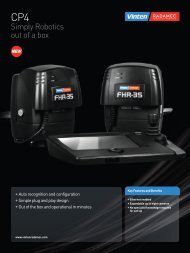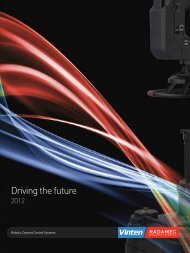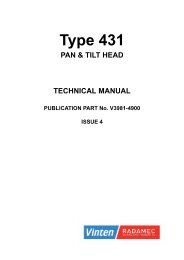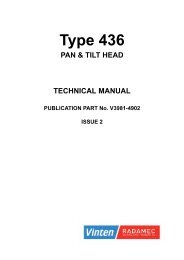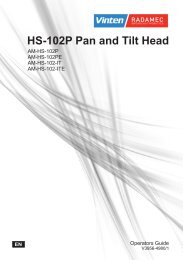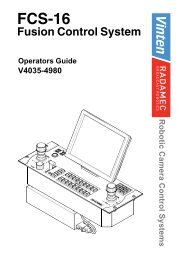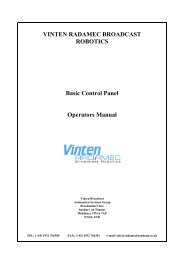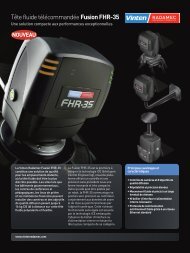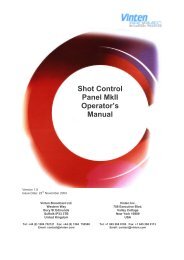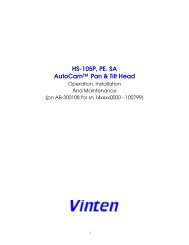SP-2000/X-Y AutoCam⢠Pedestal - Vinten Radamec
SP-2000/X-Y AutoCam⢠Pedestal - Vinten Radamec
SP-2000/X-Y AutoCam⢠Pedestal - Vinten Radamec
- No tags were found...
You also want an ePaper? Increase the reach of your titles
YUMPU automatically turns print PDFs into web optimized ePapers that Google loves.
<strong>SP</strong>-<strong>2000</strong>/X-YSafety & IntroductionAutoCam PhilosophyThe underlying goal of AutoCam is to build on the proven operating practices oftoday’s studios. Immense amounts of time and effort have gone into optimizingthese procedures, and it would be a mistake to suggest any significant change forthe sake of automation. Instead, camera automation should blend into andenhance the present studio environment, offering its substantial operating economies.On news and similar sets, one operator typically can control all of thecameras and often the CCU functions as well; and has no difficulty staying wellahead of the shots.From the outset, AutoCam was a top-down design, culminating years of discussionswith network, affiliate, independent, and EFP visionaries. It was engineeredto be expandable to accommodate the largest installations, such as 8-camera robotic-dolly studios on multiple floors, controlled from multiple locations.Yet it is also scaleable to the simplest single-camera EFP assignments.The identical system architecture is employed across this entire range of installations.Software configuration screens on the console are used to configureeach installation; as opposed to customized hardware. This stable architecturephilosophy has many benefits: easy system expansion or upgrading, better factorysupport, and higher reliability.Seamless Integration Into The StudioSuccessful camera automation should be as transparent as possible to the studiostaff, and particularly to the director. He or she should expect the same communicationswith the camera console operator, as with multiple camera operators ina traditional studio. As before, a named shot from the run-down list is relayedover the headsets. But the operator now no longer needs to continually re-framethose shots. They only need to be taught once at the console, and given the samenames that the director uses. Then, when each camera and shot is called over,the operator touches that name on the touch screen, sending the specified camerato that shot. AutoCam is also flexible and intuitive, and changes in the rundownare easily accommodated. Stories may readily be dropped or stretched orreordered as studio events unfold in a dynamic manner.“Like Being Behind A Camera”Effective camera automation should also be as transparent as possible to thecamera operator. In designing the console, a great deal of effort was devoted topresenting essentially the same controls that are present at the camera: a pan/tilt“bar”, and zoom, focus, pedestal, and dolly controls. Further, considerable engineeringwent into making the controls smooth and responsive, so that they havea quality feel like the controls on a camera. This allows both fast and reflexiveoperation, and superior on-air movement quality. To complete the “behind-thecamera”analogy, a color monitor at the console reproduces the viewfinder. The1-14 User Manual



